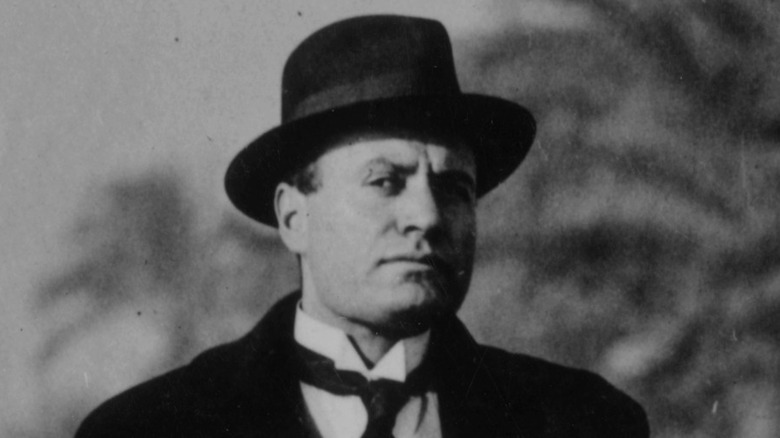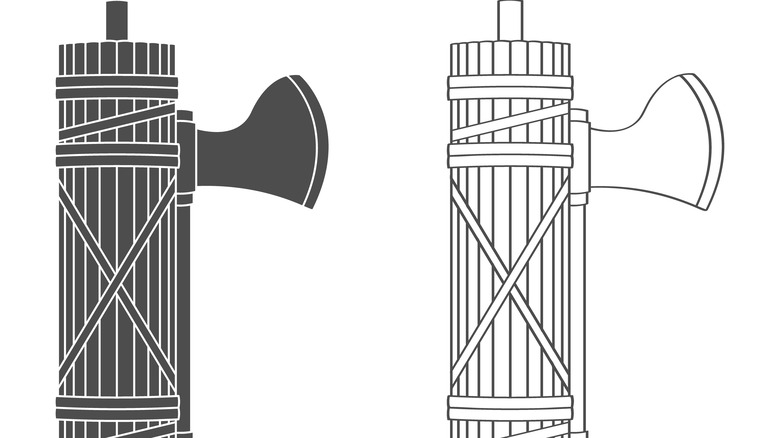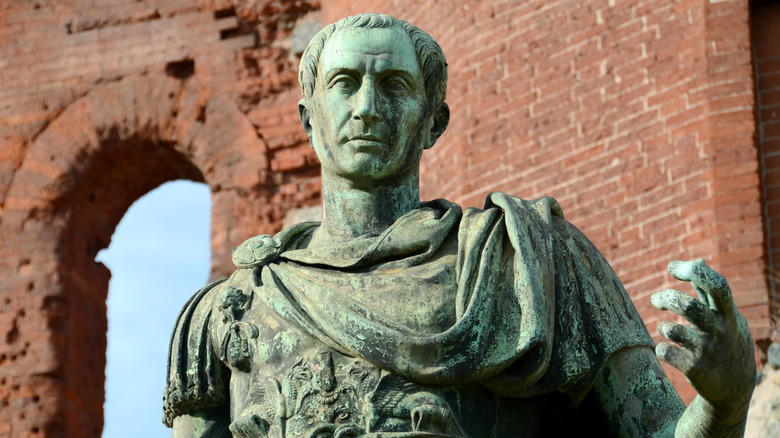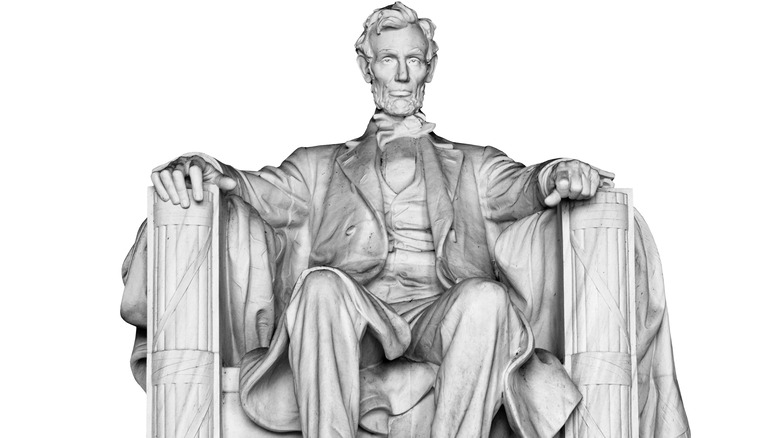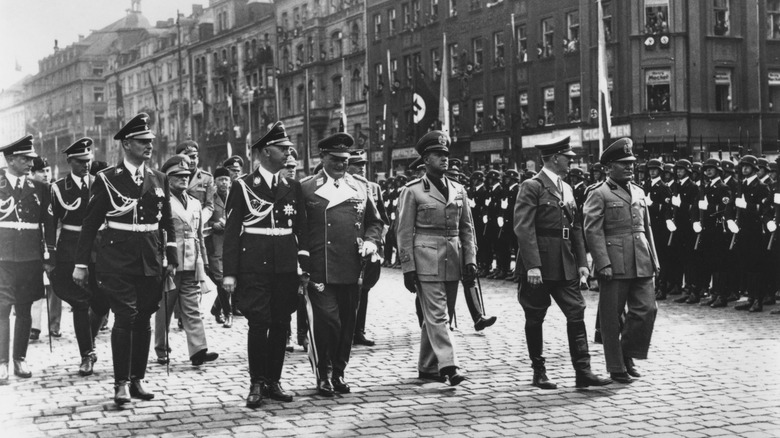How An Ancient Roman Symbol Became Associated With The Politics Of Benito Mussolini
Picture yourself in the Roman Empire 2000 years ago: You're walking through the streets of Rome as a parade of soldiers and centurions celebrate their military victory in some distant land. You notice multiple people carrying around broken branches of elm or birch trees tied to an axe with. As famous generals stroll past, people raise these bundles to salute them. Flash forward to the early 20th century, and you'd see these same symbols used in support of Benito Mussolini, the Italian dictator who popularized fascism in Europe, paving the way for the Nazi party in Germany and eventually World War II (via Britannica).
These bundles were known as fasces, and they represented military might, law, and order. They also were the epitome of corporal punishment, according to Hyperallergic. People would follow consuls — elected Roman officials — around the city, and whoever the consul deemed should be attacked was done so with the fasces. The axe also served as a way to quickly execute someone, usually outside of the city bounds, states Hyperallergic.
Original usage
The fasces symbol was probably created somewhere near central Italy, likely in the kingdom of Etruria, according to Hyperallergic. But this isn't 100% fact, and there are some critics of this belief, states Livius. Fasces have only been found in the general location, but that doesn't necessarily mean that was their birthplace. It could suggest that archaeologists just haven't uncovered any other sets from different areas. However, the symbol didn't just project authority. More accurately, the symbol was used to envision the magnitude of strength the Roman Empire possessed (via Hyperallergic).
On top of that, fasces would be presented in different manners to evoke different meanings for the events they were in. For example, if the axe was left out of the fasces, it represented an apology or a request to the people (via Livius). Sometimes the fasces was cloaked if the city was in a mourning period.
Symbol of power
However, the fasces kept their core representation of power when Roman officials would travel abroad, or even on the outer edges of their empire. Sometimes consuls carried around fasces that had two-faced axes that represented the ability to punish Roman soldiers (via Hyperallergic). Many people who lived outside the empire also associated the fasces as a sign of imperialism, like the Egyptians when Julius Caesar visited Alexandria carrying one of his fasces.
If you were a consul or some other Roman official with the right to have a fasces, it was probably best if you didn't let anyone break the bundle of sticks and axe. One Roman consul, Bibulus, had his fasces broken, and then had human waste dumped on him, according to Hyperallergic. Interestingly, although fasces were usually reserved for men, there were some women who were given the privilege to own one. Two of these women were Livia, Augustus' wife, and Agrippina, his great-granddaughter (via Hyperallergic).
Fasces throughout time
Long after the Roman Empire's fall, the fasces became more tied to the idea of strong governance. Over time, it was used in American and French culture after their revolutions to convert to a republic instead of a monarchy, something that Rome was often celebrated for (via Livius). If you take a trip to Washington, D.C. today, you can see multiple fasces throughout the architecture. One of the most notable examples is the Lincoln Memorial. In the memorial, Abraham Lincoln is sitting on a throne-like chair, with his hands on two armrests. But if you look closely you'll notice that the armrests are fasces themselves. Notably, however, they are lacking the axe in them (via NPS).
At the base of the stairs outside the Lincoln Memorial there is another fasces symbol. It has 13 different rods inside of it, all tied together with a leather strap. The 13 rods represent the original 13 colonies that seceded from the British Empire, and the combining of all of them represents how they are all united with one another, according to NPS.
Benito Mussolini
Decades after the presidency of Abraham Lincoln, the fasces was perverted for some darker messages in Italy. Benito Mussolini, the son of an Italian socialist and even a socialist himself for a time, had slowly adopted a cruel, hyper-militaristic, nationalistic, and authoritarian ideology. After he supported Italy's involvement in World War I, he was kicked out of the Socialist Party and began to despise them the most. His precursor to the Fascist Party was the Fasci Italiani di Combattimento, which meant Italian Combat Squads (via History).
These combat squads often attacked and assaulted socialists in Italy, and they became known as the Blackshirts, who were often paid by the elite of Italian society, according to History. Eventually, the group evolved into the Fascist Party, which adopted the fasces as its main symbol, per NPS. Mussolini quickly rose to power and allied himself with Adolf Hitler during World War II, according to History.
Fascism today
After the rise of Mussolini, fascism took off across Europe, the United States, and even parts of the Middle East and South Africa. The most well-known fascist organization was the National Socialist German Workers' Party, more commonly known as the Nazi Party in Germany, according to Britannica. But different fascist organizations also took root elsewhere as well. France alone had roughly 700,000 to 1.2 million members, states Britannica.
In the 21st century, the fasces is still used as a symbol in support of fascism. In the United States specifically, many fascist organizations use the symbol at rallies, protests, or even on fliers, according to ADL. At the Charlottesville "Unite the Right" rally, which ended up causing the death of three people (per NPR), a group of neo-Nazis had the fasces symbol on shields, states Hyperallergic. Many of these fascist groups commit hate crimes against minorities and tend to be white nationalists (via ADL). Though the significance of the symbol has changed throughout history, it still resonates with its original meaning: the power of the state, and violence against those who disagree with it.
If you or a loved one has experienced a hate crime, contact the VictimConnect Hotline by phone at 1-855-4-VICTIM or by chat for more information or assistance in locating services to help. If you or a loved one are in immediate danger, call 911.
